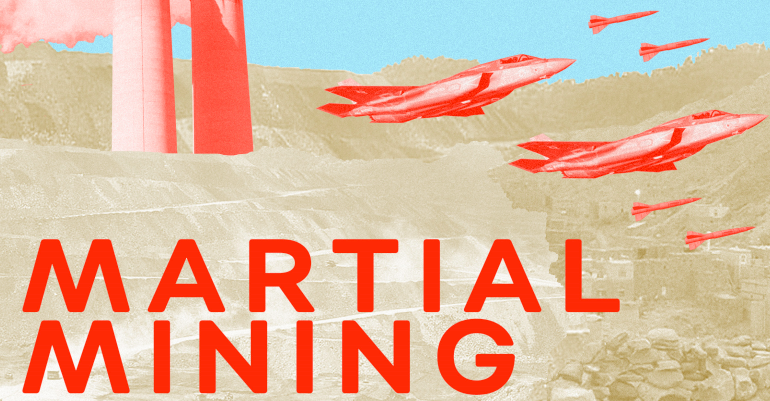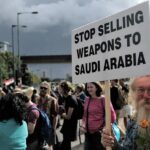Martial Mining – The link between warfare and resource extraction

On the 6th November 2020, Environmental Conflict Day, social and environmental justice coalition, the London Mining Network, launched their latest report: Martial Mining. This research analyses the relationship between mined minerals and their application in military technologies, as well as the need for militarism in the mining process. Written by researcher Daniel Selwyn and designed by Kay Stephens, the report is a crucial intervention linking resource extraction, the arms trade, militaries, and fossil capital.
In this piece, Harry Holmes interviews Daniel Selwyn on the Martial Mining report and its importance to climate justice movements.
HH: To start, what would you say was the impetus for the report?
DS: I guess it originated in an acknowledgement that these issues are not really in the mainstream of the climate movement here in the UK. The issues of militarism, war, and climate change are often treated as separate. But many of the communities and social movements affected by mining which London Mining Network works with—from Colombia and Brazil, to Eritrea and South Africa, to the Philippines and Indonesia—know intimately that resource extraction is irreducibly entangled with military force and strategies. The arms trade, private security companies and mercenaries, state militaries, the police, and other technologies of surveillance all work together to make mining possible, which in turn makes war possible.
This cycle is something the UK climate movement needs to talk more about and act to interrupt. When we talk about the military it’s mainly focused on carbon emissions from operations, or the ecological devastation of war. It’s great that it’s becoming more common knowledge that the US military is the world’s single largest polluter. Recent research by Declassified UK also found out that the UK’s military-industrial sector pollutes more than whole nations like Madagascar and Zambia. But because London Mining Network works at the base of global supply chains—the extractive zones of the Global South—we felt the need to make an extra step to highlight that fighter aircraft, nuclear submarines, drones and every other piece of military equipment are all assemblages of resources extracted from the earth, leaving polluted lands, waters, and devastated livelihoods in their wake.
We are also aiming to be part of a broader discussion and international movement that understands ecocide as a form of genocide. In doing so, this locates our understanding of warfare on a continuum from the spectacular and brutal violence we see in the wars in Yemen, Somalia or Afghanistan, not only with military bases where weapons are tested, but also the zones of extraction that underpin global warfare. In other words, it helps us understand that mining itself is overwhelmingly conducted in a warlike, or martial, manner.
By bringing together insights experienced and resisted by communities and movements across the Global South, we hope this report can encourage climate movements here in the Global North to oppose not only the fossil fuel industry but also the mining industry and military. They are also primary architects of the climate and ecological crises. They depend on each other for their mutual survival, so they must be resisted together as well.
HH: There is a lot in the report around the history of colonialism and war, and how mining companies are embroiled within them. Why do you think it’s important that climate activists know about the historic links between modern mining and colonialism and war?
DS: It’s often been said that to understand where we are, we have to understand how we got here. Only then can we see the continuities and expansion of colonial, racial and ecological violence into the present. I learned this first and foremost from Black abolitionist and decolonial Indigenous scholars and social movements.
We also need to remind ourselves of the history of these companies like Anglo American, Rio Tinto and BHP to counter the narratives that frame them as positive or progressive actors at a juncture of acute planetary emergency. By tracing their histories of conquest, occupation, and white supremacy, it becomes obvious that there are no innocent multi-billion-dollar mining companies. Their capital accumulation has been, and continues to be, built on genocidal and ecocidal violence. They are the arsonists of a burning planet, no matter how much they market themselves as the firefighters.
Basically, we need to tear down every attempt at corporate greenwashing. If you look on mining companies’ reports and websites, you won’t see photos of fighter planes dropping missiles but electric vehicles and wind farms. But their minerals are just as essential to the industries of war and death.
However, it’s important to emphasise this is not just a history of plunder and theft. The histories of these companies are also a counter-history of resistance and struggle against mining, colonialism and empire. As movements today, we need to build on these struggles, rather than attempting to remake our struggle against extractivism from scratch. We also need to connect this past to the present.
Sometimes it feels like the UK climate movement can neglect to see the movements around us, struggling at the point of extraction of fossil fuels or minerals. London Mining Network is privileged to be able to work with and take leadership from these frontline struggles—bringing social movements and community leaders to the centre of the empire to speak directly to the corporate executives plundering their resources and polluting their lands. Learning from these fights whilst living here in the UK points to the need to not just oppose mining companies on the London Stock Exchange, but also the British state and military that supports and facilitates them.
HH: As you just mentioned, we are activists at the centre of empire. How should we orient climate justice activism given the fact that these institutions are at our door?
DS: I think the answers always come through collective struggle. Hopefully the report can highlight areas where multiple forms of oppression between military and extractive industries intersect. For example, we have a whole section about the revolving door between these industries. There are key folks on the boards of both mining and arms companies, and in the highest levels of the Ministry of Defence. Lots of these companies also have the same investors, like Blackrock or Legal & General.
I think the maps within the report are also useful here. If you look at different geographies where lots of mining is occurring, you also see they are often next to military bases or ongoing British military operations, like Belize, Kenya, Oman or Brunei, for example. Here we can see where the training of troops, the selling of arms, the deployment of troops, are linked to the continued securing and extraction of minerals. The maps help to see it all as inherently connected.
We can bring together a broad ecology of movements with this information, not just those opposing the arms trade, war and mining, but also those resisting borders. Many of these arms companies also profit from militarising borders to prevent safe routes of passage for people fleeing the conflict and ecological disasters they helped to create. We also see that with Serco Group, which not only runs several immigration detention centres and the governments ‘test-and-trace’ pandemic response, but is also a major beneficiary of the Atomic Weapons Establishment that services Britain’s nuclear bombs. These are of course made from uranium and many other resources. I think this means the climate justice struggle must always also be a struggle for migrant justice and against borders. For example, the world’s biggest arms fair happens in London every two years (DSEI). I think this should be a battleground for the climate justice movement as well.
If we follow the money, we can see from the bottom-up how all of this is connected and stop treating our campaigns as tackling insular or isolated concerns. But we’ve got to be able to imagine new ways of being in relation to each other, seeing our struggles as shared and indivisible despite being differentiated in many ways.
HH: Another interesting feature of the report, is just how much detail you go into with regards to the specifics of each mineral, both their chemical uses and their extraction. Why do you think this almost scientific information is important for environmentalists to know?
DS: I think it helps to know just how much waste and violence concentrates in extractive zones to warn us off false promises and solutions. We see them in the form of geo-engineering like carbon capture and storage, but also rapid electrification and all these big infrastructural projects that are being initiated so capitalism can mostly continue as usual. Where do all the minerals come from for this? What legacies will this leave in communities around the world?
I think I’m sceptical of many of these solutions because the military themselves are often driving forces behind them, and other responses to the climate crisis. The Ministry of Defence is starting to talk about changing military strategy, where their bases are, and what technologies they use, to ‘adapt’ to a 3-6°C warmer world. When we talk about grand techno-fixes that require massive expansions of resource extraction, we have to seriously think about who we are allying ourselves with—like the military and mining industries—and who we treat as disposable in that process.
I think the report shows that we can’t get into an arms race with a state, even if we wanted to. Every aircraft carrier, submarine or drone is already a climate catastrophe of toxic waste and polluted landscapes from resource extraction. Thinking about nuclear bombs, like those dropped on Hiroshima and Nagasaki, also means thinking about the uranium sourced from mines in Shinkolobwe in the Congo, then under Belgian colonial rule. So, I think the conversation must come round to large-scale disarmament if not abolition of the military as we know it.
By looking at the science of what minerals are used for and where they come from, it also provokes the question about what is a social good. With London Mining Network, we have an education project where we go into schools and universities to talk about the minerals in our smartphones. It’s always a broad discussion, but we often agree that phones are social goods, they help keep us connected, particularly in these times. But then how do we have them without the social and ecological harm that currently concentrates at the bottom of the production chain. Often, young people’s visions are less constrained. They might say that everyone in the chain should paid the same wage with the same labour rights, from cobalt mines in the Congo to Foxconn factories in China and Apple store workers in London. A few of them even suggesting abolishing the motive to make profit from consumer electronics altogether! But I think most of us would agree that drones, border walls and nuclear weapons are not social goods. No-one would agree to a mine potentially destroying their lands and waters to facilitate even more warfare and violence.
At London Mining Network, we start from the perspective that communities should have the right to say no to mining. For example, London Mining Network has worked alongside the Amadiba Crisis Committee, whose struggle to resist a titanium mine in Xolobeni in South Africa in the face of brutal state repression successfully won the ‘Right to Say No.’ That titanium could have gone on to be used in fighter aircraft or missiles dropped in Yemen or Palestine. Thinking alongside these movements opens space to think about multiple cosmologies and relations to land, including how it connects us to our ancestors and descendants. These struggles make the ongoing conflict between the worlds we want to live in and the one we have visible and impossible to ignore.
HH: Thinking about the role of the military, the idea of military greenwashing stands out. How do we deal with cases like the recent fires in the Amazon, where Global North activists called for military intervention in the rainforest from European militaries? How do we ensure that our environmentalism is anti-imperialist and anti-militaristic?
DS: I think the most important thing is to take leadership from the Global South, communities that know we’re not just fighting fossil fuels and carbon emissions, but the historical and global structures of colonialism, capitalism and empire, which have the mining industry and military at their core.
We’ve also got to be vigilant against militarised environmentalism, as you say. For example, the UK Ministry of Defence and DEFRA are working together on anti-poaching projects in countries like Malawi and Gabon by training park guards and police, and providing them with military equipment often used against people displaced by those national parks. Projects like this go alongside expanding militarism in the Arctic, outer space, and the depths of the ocean.
I think what we’re seeing is this momentum of collapse from capitalism’s internal contradictions at these frontiers, and the military is at the forefront of all of them. Take the talk of asteroid mining in Fully Automated Luxury Communism for example, I think this comes from being disconnected from frontline communities. Who overwhelmingly owns the means of production and expansion there? The military-industrial sector. What we need is to stop the harm and violence here, before moving to healing and repair.
Environmentalists need to question themselves when they end up allied with the military or arms industry. Lots of this comes from realising that environmentalism is not inherently progressive or transgressive. It can lend itself just as well to a blood and soil eco-fascism as it must to a genuinely liberatory politics.
HH: This might be difficult, but what would you say is the main takeaway you hope people have from the report?
DS: Probably that extractivism, the arms trade, and global warfare are inextricably linked and that they must be resisted as such. Also that we need to take leadership from the communities in the Global South—and Indigenous and racialised communities in the Global North—that have known and fought for their survival and liberation against these forces for centuries before any climate movements here realised as much. That we must ground our struggles for global climate justice in transnational solidarity which embraces a plurality of visions for the worlds to come.
The Martial Mining report can be downloaded here. To contact the London Mining Network to organise a talk about this research or any other aspects of their work contact them at education@londonminingnetwork.org
Daniel Selwyn (@redrosaroo) is a researcher and educator with the London Mining Network, an alliance of 21 organisations working to expose human rights abuses and environmental crimes committed by mining companies based in London, and campaigning for social justice and the ecological integrity of the planet.




Leave a Reply